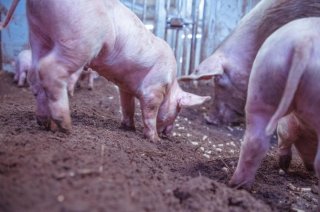
Impact story
Better welfare for pigs
Pigs display less biting behaviour when living a comfortable, social, energetic life. Wageningen University & Research (WUR) expertise contributes to animal-friendly sties and other welfare-enhancing concepts.
The farm ‘Het Familievarken’ (the family pig) is located in Venhorst, Brabant. Here, the pigs’ needs come first. The sty floors are covered in a thick layer of sand, enabling them to root to their heart’s content. Research conducted by Wageningen University & Research lies at the basis of this farm. Here, all sorts of ideas related to pig welfare are included in a barn concept where they are tested in practice.
The goal is to develop a financially viable barn where pigs can be raised comfortably and with room for their natural behaviour.
Scientifically substantiated
Pigs are curious animals. When they are uncomfortable or bored, they turn on each other, which results in tail biting and infections. The pilot farm focuses on pigs’ social behaviour to mitigate such welfare issues. ‘Scientific studies show that contact between pigs at an early age fosters social skills, preventing them from biting each other’, says Liesbeth Bolhuis in Wageningen World. This is why piglets are kept with their mothers for an additional week and are kept with other piglets and sows when they are young.
The pig toilet is another innovation that is currently under development. In a traditional sty, the urine and faeces flow together, creating ammonia. Ammonia causes acidification of the soil, negatively impacting plants and animals. Moreover, ammonia fumes cause stress for the pigs. To prevent this, the pig toilet stores the urine and faeces separately, which is expected to reduce the emission of ammonia by as much as 60%. Moreover, pigs will naturally seek separate places to sleep and to relieve themselves. The pig toilet thus meets their natural needs.
Room to be pigs
WUR scientists also contributed to the development of the Pig Plateau 2.0 in collaboration with farmers, government and animal protection services. This two-storey barn design offers the pigs up to 40% more room to move around in. Additionally, the farmer can use this extra space for toys, a wood chip pit or other enrichment materials. Seventy farmers in the Netherlands, Germany, Belgium and France are using this concept. The pigs are enthusiastic also; an average of 95% ascends the ramp to the second floor.
- Unfortunately, your cookie settings do not allow videos to be displayed. - check your settings
Wageningen Livestock Research wrote a brochure on enrichment (in Dutch), explaining what options the farmer has to enrich the barn according to the NVWA (Dutch Food and Safety Authority) standards. The NVWA checks for nine criteria: safe, edible, chewable, can be used for rooting, degradable, innovative, accessible and clean. The 2019 inspection showed that approximately one-third of the businesses meet the standards for proper barn enrichment. Moreover, Wageningen Livestock Research contributed to the development of a welfare-check, a management tool to improve the pigs’ wellbeing and health.
Thus, WUR applies its extensive knowledge of pig behaviour to helping farmers keep their pigs in an animal-friendly manner.